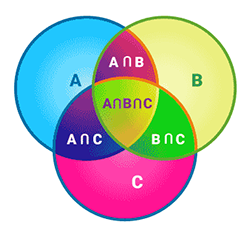
When I took high school algebra in 1963 it was taught as Set Theory, an element of New Math. Forced to teach New Math, Miss Lewis, who was nearing the end of her long career, had as little understanding of what she was teaching as we students had of what was being taught. What previously had been the straightforward study of axioms and equations instead became an exercise in intersectionality, a mathematical foreshadowing of deconstructive postmodernism and today’s identity politics. If I’d been wiser at the time, I’d have seen all this coming, but I was a confused, self-obsessed, ignorant fourteen-year-old – one among many.
The origin of Set Theory, a system of logic using classes of objects, is generally credited to the mathematician Georg Cantor (1870). {Sets} are objects that interact according to axioms, which govern their operations. The objects in a set may have various characteristics that allow them to be classified in multiple subsets. In this way, intersectionality is introduced; the now ubiquitous Venn Diagram is used to demonstrate how sets intersect and influence outcomes. Back then, I found it quite confusing. Reportedly, the Set Theory paradox of an infinity of infinities drove Georg Cantor mad.

New Math certainly drove me crazy; I failed, along with half the class. Miss Lewis promptly retired. I repeated and passed algebra in my sophomore year, taught the traditional way by Miss Polinger. As I observe the workings of society in our present age, I can see how the logic of New Math has influenced our conceptions of self and other, and how its maddening paradoxes now vex politics, sexuality, and identity. The convergence of hyper-reflexive inwardness with the imperatives of common social reality is producing intense discomfort and upheaval.
We are all members of the absolute set of {human beings}. Classified this way, no differences within the set exist, but only absolute solutions can be calculated, limiting its value. For example, {human beings} all have livers and kidneys, a helpful characteristic of the set when it comes to modern medicine, but not of much value otherwise. As we know, however, within the set of {human beings} are subsets: {men}, {women}, {children}, and {adults} and these sets can be further elaborated into {age}, {ethnicity}, {wealth}, and so forth. Subsets inevitably become infinite, and the equal logical value of any proven set governed by an axiom may explain why poor Georg Cantor went mad and why contemporary society appears to be going mad as well.
Conceptions {sets} of {self} and {other} have always vexed humanity. Notably, the null set of {zero} caused profound chaos within the Catholic Church before it assumed its legitimate place in thought. Not simply a problem of western society, Buddhism seeks to solve the paradoxes of self and other with its own axiom of emptiness, for some an idea as maddening as contemplations of zero and infinity. Algebra itself was invented in the 9th century by an Islamic mathematician, a fact Miss Lewis failed to disclose.
For all our collective social drama and displays, inclinations towards inwardness have steadily increased during the past couple of centuries. As the set of {self} predominates, the popularity of Yoga, meditation, Twitter, TikTok, and posting personal opinion has grown, intersecting the thorny subset of identity politics.
Algebra describes mathematical relationships and transformations. So too the operations of Set Theory, but nowadays not just mathematically, but socially as well.
I shared a similar experience, but have never recovered from my math-trauma or understood set theory. Your analysis of how it has infiltrated our socio-political consciousness both frightens me and reassures me. The fright arises from the attempt to take, as you point out, things that are relatively clear and accessible and obfuscate their essence and, instead, create something “new”. The reassurance comes from recognizing that regardless of theory, we are all still here.
Thanks for the comment, Mary. Our granddaughter is now 14 and taking high school algebra. Lo and behold, her homework included a Venn diagram. Turns out she loves algebra…go figure. That we are are still here IS reassuring. The Buddhist name for our world system is SAHA, which translates as “endurance.” Says it all.
I was an 8th grade student at a parochial school in Colorado in 1964 when the awful “new math” was foisted upon us. All I remember today is the {null} set, which we at the time couldn’t even comprehend. How can something contain “less than zero?” =D
We ended up using it as the ultimate insult – if we thought someone to be stupid, we told them their IQ was {null}
I learned to hate “new math” so much that one day while doing an assignment I slammed my book (with the assignment sheet inside) shut, threw it on the floor and yelled “$#*t on this!!”
A second later my teacher, a sweet and lovely (truly) nun that we all liked, called me out quietly into the the hall and then asked me “WHAT did you just say?”
I will never forget how much we all hated “new math.” Years later when I got an electrical engineering degree (tons of math, science, physics and calculus) I don’t recall seeing any of it, and that was fine by me.